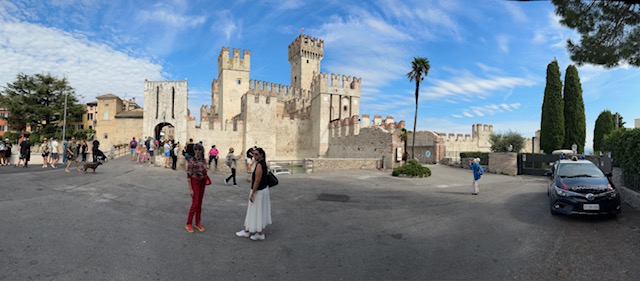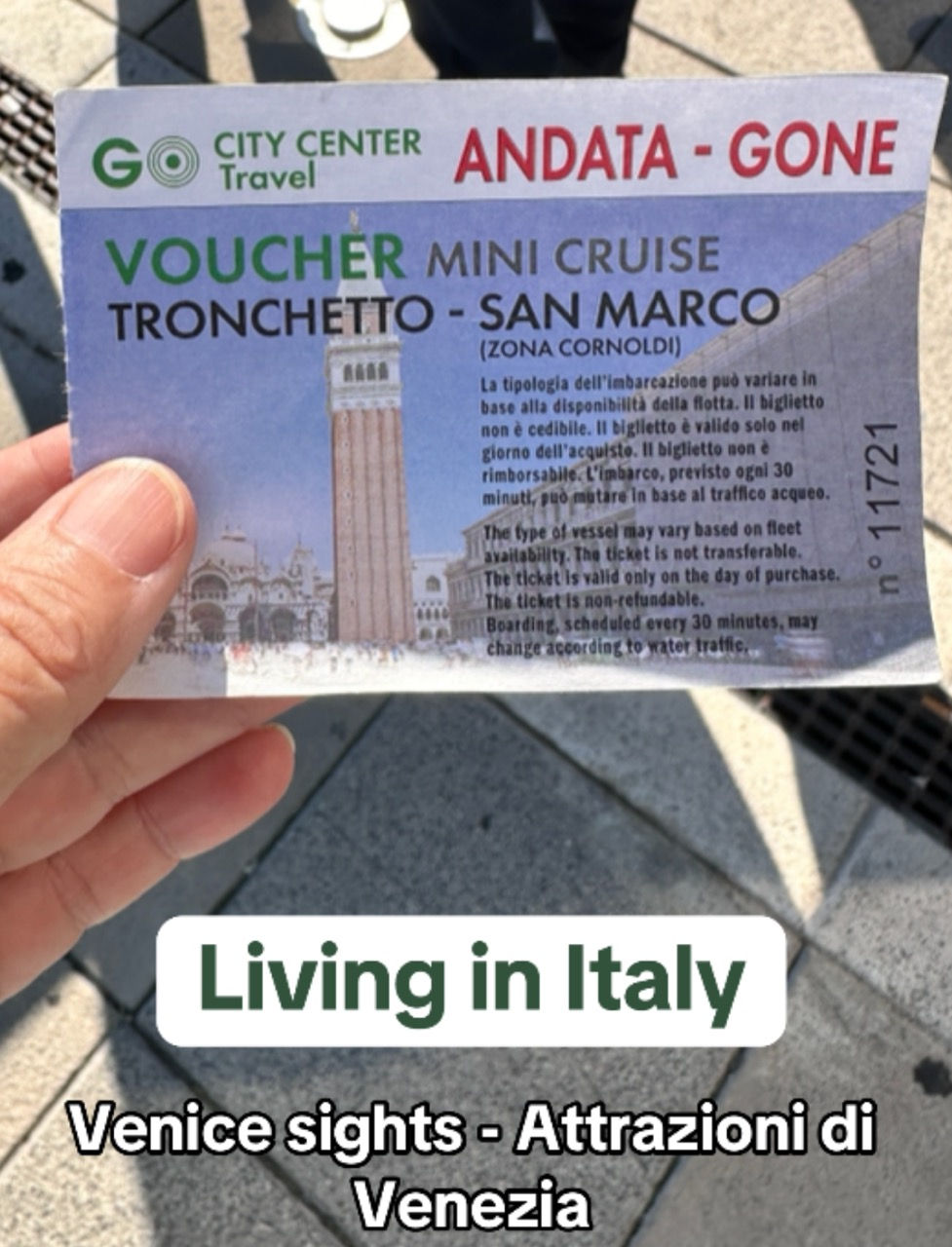Sirmione Lake Garda – Sirmione Lago di Garda
- Maria Scuor
- Dec 30, 2023
- 9 min read
Italiano in ogni sezione
For my 60th birthday Crystal, Chris, Ariana and Ruxi surprised me with a two day adventure to Sirmione, and what a beautiful place to spend my birthday. Sirmione is a small municipality in the province of Brescia in Lombardy, Italy and its historic center stands on a peninsula that divides the lower Lake Garde. With 8,200 inhabitants, the towns main industry is tourism, due to the presence of Roman and Medieval remains and the thermal waters.
Here is a TikTok video of our adventures in Sirmione - Ecco un video TikTok delle nostre avventure a Sirmione
First traces of human presence in Sirmione dates back to the 6th-5th millennia BC. By the 1st century BC, Sirmione became a favourite resort for the rich families coming from Verona, then the main Roman city in north-eastern Italy. Catullus, a renowned poet, praised the beauty of the city and wrote about the villa he had in the area.
By the 4th-5th centuries, Sirmione became a fortified strongpoint defending the southern shores of the lake. Sirmione was a free comune, but then in the 13th century fell into the hands of the Scaligers, the ruling family of Verona, who built the castle (fortress) that exists today. The military role of the city continued until the 16th century, however a garrison (group of troops) remained in the castle until the 19th century. Sirmione was possessed by Venetian Republic, then Habsburg Empire and finally became part of the Kingdom of Italy in 1860.
Sirmione è un piccolo comune in provincia di Brescia in Lombardia e il suo centro storico sorge su una penisola che divide il basso Lago Garde. Con 8.200 abitanti, l'attività principale della città è il turismo, grazie alla presenza di resti romani e medievali e alle acque termali.
Le prime tracce della presenza umana a Sirmione risalgono al VI-V millennio a.C. Nel I secolo a.C., Sirmione divenne una delle località preferite dalle ricche famiglie provenienti da Verona, allora la principale città romana dell'Italia nord-orientale. Catullo, rinomato poeta, lodò la bellezza della città e scrisse della villa che aveva nella zona.
Tra il IV e il V secolo, Sirmione divenne una roccaforte fortificata a difesa delle sponde meridionali del lago. Sirmione era un libero comune, ma poi nel XIII secolo cadde nelle mani degli Scaligeri, la famiglia regnante di Verona, che costruì il castello (fortezza) che esiste oggi. Il ruolo militare della città continuò fino al XVI secolo, tuttavia una guarnigione (gruppo di truppe) rimase nel castello fino al XIX secolo. Sirmione fu posseduta dalla Repubblica di Venezia, poi dall'Impero Asburgico e infine entrò a far parte del Regno d'Italia nel 1860.
The quaint little town is absolutely beautiful and here are some of the sights we saw. La pittoresca cittadina è assolutamente bellissima e qui ci sono alcuni dei luoghi che abbiamo visto.
Sights - Luoghi
Our B&B was in the modern part of Sirmione and a four km walk to the fortified entrance of the historic center. Our walk was pleasant as there were many sights to see as well as Lake Garde.
Il nostro B&B si trovava nella parte moderna di Sirmione e a quattro km a piedi dall'ingresso fortificato del centro storico. La nostra passeggiata è stata piacevole perché c'erano molte attrazioni da vedere e il lago Garde.
Here are some photos of the sights we saw during our walk. Ecco alcune foto dei luoghi che abbiamo visto durante la nostra passeggiata.
Lake Garde – Lago di Garda
Lake Garda is the largest lake in Italy and a very popular holiday location in northern Italy. The lake cuts into the edge of the Italian Alps and sits at an elevation of 65 m (213 ft) . The lake and shorelines are divided between the provinces of Brescia, Verona and Trentino. The name Garda has evolved from the Germanic word warda, meaning “place of guard”, “place of observation” or “place of safety”.
This lake has a length of 51.6 km (32.1 mi) and is 16.7 km (10.4 mi) wide. Its average depth is 136 m (446 ft) and has a maximum depth of 356 m (1135 ft). At a magnificent 370 square km (143 square mi), it is more than 75% larger than Lake Maggiore we live on. Because of the state, regional, provincial roads and highways make it possible to drive around the whole lake, you can drive the 158.4 km (98 mi) perimeter (shoreline).
There are five main islands as well as many smaller ones spread throughout the lake.
The largest is Isola La Garda (or Borghese) located near western shore and features a magnificent private villa that is available for tours
To the south is Isola San Biagio or Isola dei Conigli (Island of Rabbits), which has a population of wild rabbits who are acclimated to humans. The island is available for day or overnight beach use as it features clear waters and rock wall, which draws scuba divers
On the east coast of the lake is Isola di Trimelone which once was a military outpost leftover from Austro-Hungarian rule. Half of the island was destroyed due to an explosion in 1954 and today it is a quiet oasis inhabited by seagulls and cormorants.
Further north up the eastern shore is Isola di Sogno (Island of Dreams) and Isola dell’Olivo (Island of Olive Trees). Both are located of the shore of the medieval hamlet Malcesine and neither are inhabited.
Depending on water levels, Isola di Sogno and Isola San Biagio can be accessed on foot by land bridges. The other three islands require boat transportation to visit them
We were lucky to visit Sirmione, but there are 25 other comuni on Lake Garda with Desenzano di Garda, Arco and Riva del Garda being the most populated. As Sirmione, Lake Garda’s economy is based on tourism. In the Roman times, there were magnificent villas on the shores of the lake. Sirmione was privileged because of the presence of sulphurous springs that allowed thermal use and many rich families came to enjoy them.
There are many resorts along the lake that can accommodate short and long stays, but tourism got a big boost in July of 1975 when Gardaland Resort was built. This is the biggest theme park in Italy and hosts over 3 million visitors per year. Located adjacent Lake Garda, the resort includes: Gardaland Park, Gardaland Sea-Life, Legoland Waterpark, Gardaland Hotel, Adventure Hotel and Magic Hotel.
Il Lago di Garda è il lago più grande d'Italia e una località di villeggiatura molto popolare nel nord Italia. Il lago taglia il bordo delle Alpi italiane e si trova ad un'altitudine di 65 m. Il lago e le coste sono divisi tra le province di Brescia, Verona e Trentino. Il nome Garda deriva dalla parola germanica warda, che significa "luogo di guardia", "luogo di osservazione" o "luogo sicuro".
Questo lago ha una lunghezza di 51,6 km ed è largo 16,7 km. La sua profondità media è di 136 m e ha una profondità massima di 356 m. Con una magnifica superficie di 370 km quadrati, è più grande del 75% rispetto al Lago Maggiore in cui viviamo. A causa delle strade statali, regionali, provinciali e autostradali che consentono di guidare intorno a tutto il lago, è possibile guidare il perimetro di 158,4 km.
Ci sono cinque isole principali e molte più piccole sparse in tutto il lago:
1 - La più grande è l'Isola La Garda (o Borghese) situata vicino alla costa occidentale e dispone di una magnifica villa privata che è disponibile per tour
2 - A sud si trova l'Isola San Biagio o Isola dei Conigli, che ospita una popolazione di conigli selvatici acclimatati all'uomo. L'isola è disponibile per l'uso diurno o notturno in spiaggia in quanto presenta acque limpide e parete rocciosa, che attira i subacquei
3 - Sulla costa orientale del lago si trova l'Isola di Trimelone che un tempo era un avamposto militare residuo del dominio austro-ungarico. Metà dell'isola fu distrutta a causa di un'esplosione nel 1954 e oggi è un'oasi tranquilla abitata da gabbiani e cormorani.
4 - Più a nord, lungo la costa orientale, si trovano l'Isola di Sogno e l'Isola dell'Olivo. Entrambi si trovano sulla riva del borgo medievale di Malcesine e nessuno dei due è abitato.
A seconda del livello dell'acqua, l'Isola di Sogno e l'Isola San Biagio sono raggiungibili a piedi tramite ponti di terra. Le altre tre isole richiedono il trasporto in barca per visitarle.
Noi abbiamo avuto la fortuna di visitare Sirmione, ma ci sono altri 25 comuni sul Lago di Garda con Desenzano di Garda, Arco e Riva del Garda che sono i più popolati. Come Sirmione, l'economia del Lago di Garda si basa sul turismo. In epoca romana c'erano magnifiche ville sulle rive del lago. Sirmione era privilegiata per la presenza di sorgenti sulfuree che permettevano l'uso termale e molte famiglie benestanti venivano a goderne.
Ci sono molti resort lungo il lago che possono ospitare brevi e lunghi soggiorni, ma il turismo ha avuto un grande impulso nel luglio del 1975 quando è stato costruito Gardaland Park. Si tratta del parco tematico più grande d'Italia e ospita oltre 3 milioni di visitatori all'anno. Situato adiacente al Lago di Garda, il park comprende: Gardaland Park, Gardaland Sea-Life, Legoland Waterpark, Gardaland Hotel, Adventure Hotel e Magic Hotel.
Here are some photos of Lake Garda we saw during our walk. Ecco alcune foto del Lago di Garda che abbiamo visto durante la nostra passeggiata.
Scaliger Castle - Castello Scaligero
The Scaliger Castle is a fortress and access point to the historical centre of Sirmione. It is one of Italy’s best-preserved castles and in 2019 was the 22nd most visited castle in Italy with more than 308,000 visitors per year. Due to the long line up, we didn’t get to go inside the castle but we were in awe of its beautiful outer architecture.
The castle was built in the later half of 14th century on behalf of the Della Scala family of Verona, known as the Scaligeri, from which the castle gets its name. This family ruled Verona from 1259 – 1387. In 1405 the Scala family submitted to Venice and was then controlled by the Republic of Venice. It continued to be used as an armory and fortification until 1861, the Unification of Italy, when it became the office of the local government of Sirmione.
The castle was restored in 1919 after the damage during World War 1 but wasn’t fully restored until 2018 when the internal waters of the castle were removed.
For a leaflet on the castle https://museilombardia.cultura.gov.it/wp-content/uploads/2023/01/2.CASTELLO-SCALIGERO-DI-SIRMIONE-INGLESE.pdf
Il Castello Scaligero è una fortezza e punto di accesso al centro storico di Sirmione. È uno dei castelli meglio conservati d'Italia e nel 2019 è stato il 22° castello più visitato d'Italia con più di 308.000 visitatori all'anno. A causa della lunga fila, non siamo riusciti ad entrare nel castello, ma siamo rimasti sbalorditi dalla sua splendida architettura esterna.
Il castello fu costruito nella seconda metà del XIV secolo per conto della famiglia veronese Della Scala, detta degli Scaligeri, da cui il castello prende il nome. Questa famiglia governò Verona dal 1259 al 1387. Nel 1405 gli Scaligeri si sottomisero a Venezia e furono poi controllati dalla Repubblica di Venezia. Continuò ad essere utilizzato come armeria e fortificazione fino al 1861, anno dell'Unità d'Italia, quando divenne sede del governo locale di Sirmione.
Il castello è stato restaurato nel 1919 dopo i danni subiti durante la prima guerra mondiale, ma non è stato completamente restaurato fino al 2018, quando le acque interne del castello sono state rimosse.
il dépliant informative https://museilombardia.cultura.gov.it/wp-content/uploads/2023/02/1.CASTELLO-SCALIGERO-DI-SIRMIONE-ITALIANO.pdf
Here are some photos we took of the castle – Ecco alcune foto che abbiamo scattato al castello
Cars - Automobili
While we were in Sirmione the 15th edition of Franco Mazzotti Cup Race was driving through the town. This race takes place in the province of Brescia and is dedicated to the memory of Francesco Mazzotti, one of the founding members of the Mille Miglia Race.
The Mille Miglia was an open-road endurance race that was established in 1927 by Francesco Mazzotti and Aymo Maggi. It took place in Italy 24 times from 1927 to 1957. Cars that participated over the years were Alfa Romeo, BMW, Ferrari, Maserati, Mercedes-Benz and Porsche. The races brought out an estimated 5 million spectators.
Since 1977, the Franco Mazzotti Cup Race was reborn as a regularity race (time-speed-distance rally) for classic and vintage cars. Participation is limited to cars, produced no later than 1957 and the route is Brescia-Rome round trip.
Mentre eravamo a Sirmione la 15° edizione della Coppa Franco Mazzotti Corsa stava attraversando la città. Questa gara si svolge in provincia di Brescia ed è dedicata alla memoria di Francesco Mazzotti, uno dei soci fondatori della Mille Miglia.
La Mille Miglia è stata una gara di resistenza su strada aperta fondata nel 1927 da Francesco Mazzotti e Aymo Maggi. Si svolse in Italia 24 volte dal 1927 al 1957. Le vetture che hanno partecipato nel corso degli anni sono state Alfa Romeo, BMW, Ferrari, Maserati, Mercedes-Benz e Porsche. Le gare hanno attirato circa 5 milioni di spettatori.
Dal 1977 la Coppa Franco Mazzotti è rinata come gara di regolarità (raduno tempo-velocità-distanza) per auto d'epoca. La partecipazione è limitata alle vetture, prodotte non oltre il 1957 e il percorso è Brescia-Roma andata e ritorno.
Here are some photos of the participating cars we saw in Sirmione and some other very beautiful cars just hanging out on the streets. Ecco alcune foto delle auto partecipanti che abbiamo visto a Sirmione e di altre auto molto belle che girano per le strade.
This years route of race - Il percorso di gara di quest'anno






































































































































Comentarios